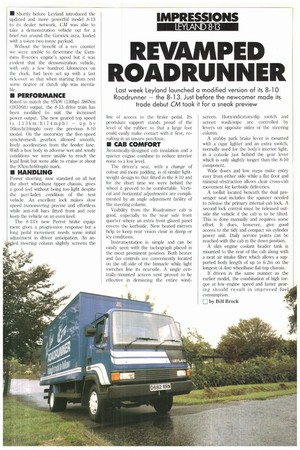REVAMPED ROADRUNNER
Page 49

If you've noticed an error in this article please click here to report it so we can fix it.
Last week Leyland launched a modified version of its 8-10 Roadrunner — the 8-13. Just before the newcomer made its trade debut CM took it for a sneak preview
El Shortly before Leyland introduced the updated and more powerful model 8-13 to its dealer network, CM was able to take a demonstration vehicle out for a brief run around the Gatwick area, loaded with a token two tonne payload.
Vv'ithout the benefit of a rev counter we were unable to determine the Cummins B-series engine's speed but it was evident that the demonstration vehicle, with only a few hundred kilometres on the clock, had been set up with a fast tick-over so that when starting from rest some degree of clutch slip was inevitable.
• PERFORMANCE
Rated to match the 97kW (130hp) 386Nm (28516f1) output, the 8-13 drive train has been modified to suit the increased power output. The new geared top speed is 1 1 3 kmih( 7 4 mph) — up by 16knvh(lOmph) over the previous 8-10 model. On the motorway the five-speed synchromesh gearbox allowed smooth, lively acceleration from the feeder lane. With a box body in adverse wet and windy conditions we were unable to reach the legal limit but were able to cruise at about the 97kmill(60mph) mark.
• HANDLING
Power steering, now standard on all but the short wheelbase tipper chassis, gives a good feel without being too light despite the part-laden condition of the test vehicle. An excellent lock makes slow speed manoeuvring precise and effortless while anti-roll bars fitted front and rear keep the vehicle on an even keel.
The 8-13's new Perrot brake equipment gives a progressive response but a long pedal movement needs some initial adjustment in driver anticipation. An aned steering column slightly screens the line ot access to the brake pedal. Its pendulum support stands proud of the level of the rubber so that a large foot could easily make contact with it first, resulting in an unsure purchase.
• CAB COMFORT
Acoustically-designed cab insulation and a quieter engine combine to reduce interior noise to a low level.
The driver's seat, with a change of colour and more padding, is of similar lightweight design to that fitted in the 8-10 and for the short time we were behind the wheel it proved to be comfortable. Vertical and horizontal adjustments are complimented by an angle adjustment facility of the steering column.
Visibility from the Roadrunner cab is good, especially to the near side front quarter where an extra front glazed panel covers the kerbside. New heated mirrors help to keep rear vision clear in damp or icy conditions.
Instrumentation is simple and can be easily seen with the tachograph placed in the most prominent position. Both heater and fan controls are conveniently located on the off-side of the binnacle while light switches line its nearside. A single centrally-mounted screen vent proved to be effective in demisting the entire wind
screen. liormindicatorsidip switch and screen wash/wipe are controlled by levers on opposite sides of the steering column.
A stubby park brake lever is mounted with a cigar lighter and an extra switch, normally used for the body's interior light, in a console just behind the gear lever which is only slightly longer than the 8-10 component.
Wide doors and low steps make entry easy from either side while a flat floor and minimal obstruction allows clear cross-cab movement for kerbside deliveries.
A toolkit located beneath the dual passenger seat includes the spanner needed to release the primary internal cab lock. A second lock control must be released outside the vehicle if the cab is to be tilted. This is done manually and requires some effort. It does, however, give good access to the tidy and compact six cylinder power unit. Daily service points can be reached with the cab in the down position.
A slim engine coolant header tank is mounted to the rear of the cab along with a neat air intake filter which allows a supported body length of up to 6.2m on the longest (4.4m) wheelbase flat-top chassis.
If driven in the same manner as the earlier model, the combination of high torque at low engine speed and faster gearing should result in improved fue, consumption.
E by Bill Brock
















































































































